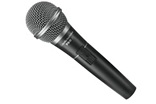 Rule number one is always use a microphone when giving a motivational speech. Don't give the guest speaker an option. Countless times, I have seen a speaker decline to use a microphone because they claim they have a loud, powerful voice, only to leave the audience annoyed because they can't hear.
Rule number one is always use a microphone when giving a motivational speech. Don't give the guest speaker an option. Countless times, I have seen a speaker decline to use a microphone because they claim they have a loud, powerful voice, only to leave the audience annoyed because they can't hear.
Because of different room set ups or noise in the adjacent room- a speaker's voice can come across as muffled or words can be missed and people have to struggle to hear. Many audience members are also hearing impaired and they will miss dropped vowels or mumbled words.
Ask a guest speaker for their preference and prep them on different microphone types:
Handheld Microphones
These microphones have a sturdy base and a large round mesh like ball that you speak into. I have found the handheld microphone tends have the clearest reception and less interference with nearby in house speakers. The drawback is only one hand is free to make gestures because the other hand has to hold the microphone up to the mouth.
Remind a guest speaker to always speak into the microphone ( bring it up to their mouth). Handheld microphones can be cordless or not. If it has a cord connecting it to a power source, the speaker has to be aware of where the cord is, so they don't trip on it!
A wireless microphone will require a battery, so test it and always have a back up.
Handheld microphones can also be attached to a microphone stand. If a guest speaker chooses to use the stand, make sure it is adjusted to the right level.
The Lapel Microphone
My favorite - this compact unit can be fastened to your pants, or carried in a pocket. A small microphone weaves across the body and is attached to a jacket lapel or shirt.Again, it is battery operated, so test the battery. Lapel microphones do tend to pick up more interference with in house speakers, so the guest speaker should test these trouble spots throughout the room to avoid shrieking sounds.
Over the Ear Microphones
These are designed to sculpt around the ear and adjust right in front of your mouth. They plug into a battery pack that can be attached at the waste. They are supposed to project the best sound with least interference ( from clothing or jingling jewelry etc) because they are positioned right in front of the mouth.Because my ears are small and rubbery, this microphone tends to fall off my ear and are hard to re adjust mid speech.
Podium microphone
Attached to the podium, this microphone allows guest speakers to prop themselves up or hide behind the microphone base and read their speech notes. For this reason, this is usually the most popular for a novice guest speaker.Unfortunately, the speech delivery can seem stifled and rigid, eye contract is buried in speech notes and overall audience connection can suffer. A speaker should position a microphone 8-10 inches from their mouth to avoid muffled sounds or popping noises.


